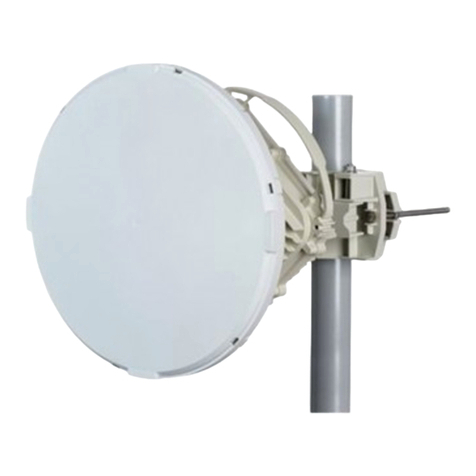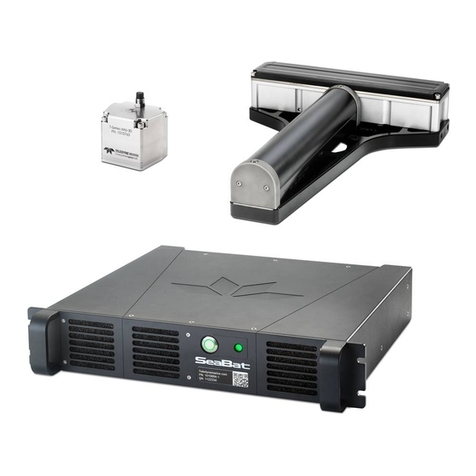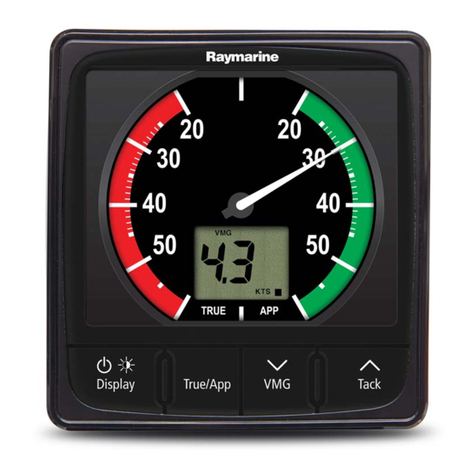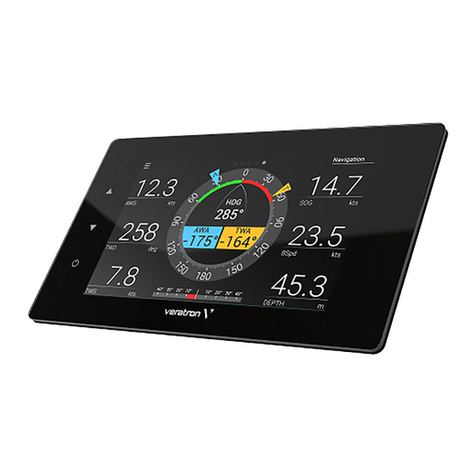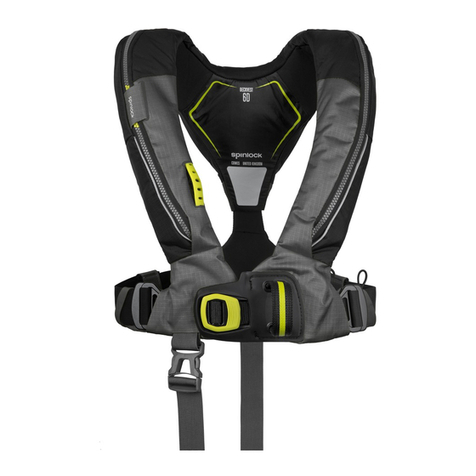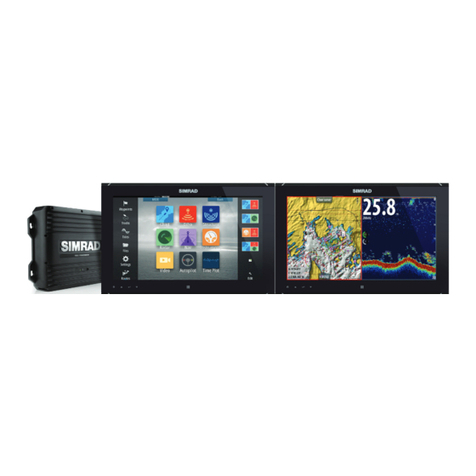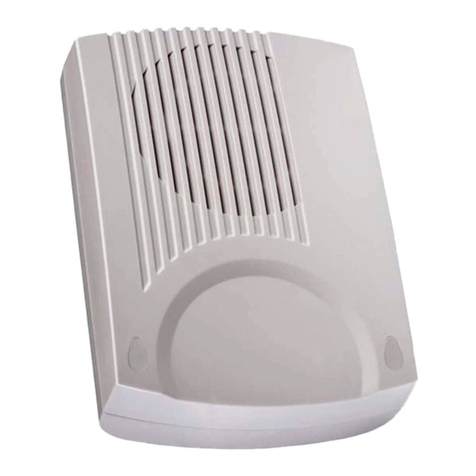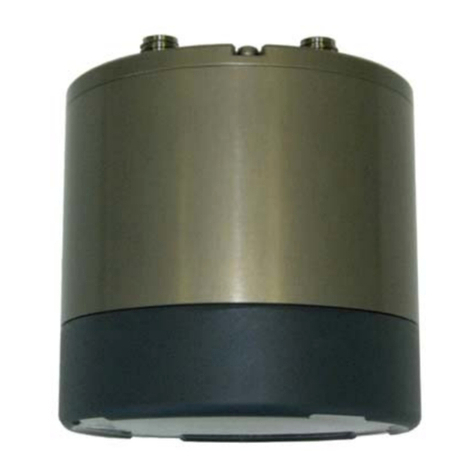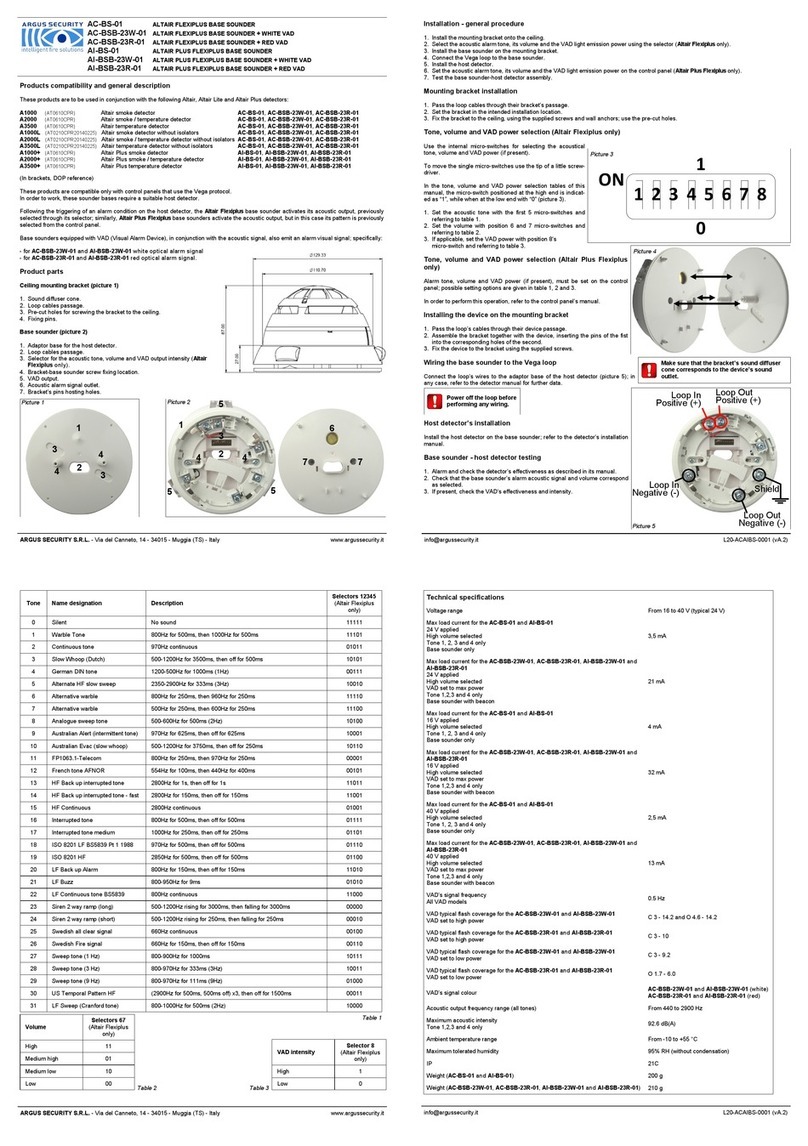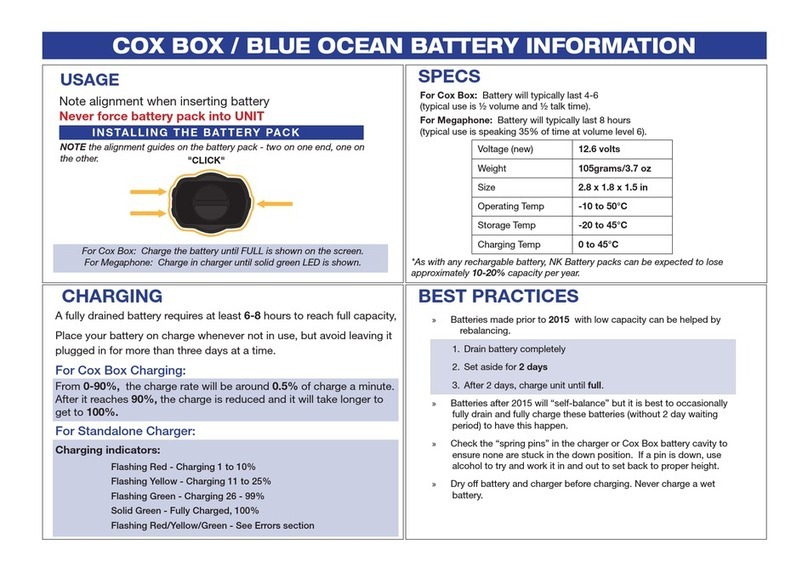Geometrics G-882 User manual

G−882 CESIUM MARINE
MAGNETOMETER
25919-OM REV. E
Operation Manual
COPYRIGHT © 2005
GEOMETRICS, INC.
2190 Fortune Drive, San Jose, California 95131 USA
Phone: (408) 954-0522
Fax: (408) 954-0902

We, Geometrics, Inc.
Geometrics Europe
2190 Fortune Drive
San Jose, CA 95131 USA
ph: (408) 734-4616
FAX: (408) 745-6131
declareunderoursoleresponsibilitythatourmarine magnetometers,modelsG-880,G-881andG−882 to which this declaration relates are in conformity
with the following standards:
EN 55022: 1995, EN50082-2 : 1995, ENV 50140: 1994, ENV 50141 : 1994, EN 61000-4-2: 1995, EN 61000-4-4: 1995
per the provisions of the Electromagnetic Compatibility Directive
89/336/EEC
of May 1989 as Amended by
92131/EEC
of 28 April 1992 and
93/68-EEC, Article 5
of 22 July 1993.
TheTechnicaldocumentationrequiredbyAnnexIV(3)of the LowVoltage Directiveismaintainedby Christopher Leech of Geometrics Europe
(address below).
Theauthorizedrepresentativelocated within theCommunity is:
Geometrics Europe
Christopher Leech
Manor Farm Cottage
Galley Lane
Great Brickhill
Bucks.MK17 9AB, U.K.
ph: +44 1525 261874
FAX: +44 1525 261867
Mark Prouty, President
San Jose, CA, USA
CE
March 14, 2003
Sunnyvale, California, USA
EC DECLARATION OF CONFORMITY
03


G-882 with Weight Collar
Depth Option & Altimeter
G-882 MARINE MAGNETOMETER
CESIUM VAPOR HIGH PERFORMANCE –Highest detection range and probability of detecting all sized
ferrous targets
NEW STREAMLINED DESIGN FOR TOW SAFETY –Low probability of fouling in fishing lines or rocks
NEW QUICK CONVERSION FROM NOSE TOW TO CG TOW –Simply remove an aluminum locking
pin, move tow point and reinsert. Now with built in easy carry handle!
NEW INTERNAL HIGH PERFORMANCE CM-221 COUNTER MODULE –UP TO 40 HZ –Provides
Flash Memory for storage of default parameters set by user
NEW ECHOSOUNDER / ALTIMETER OPTION
DEPTH RATING –4,000 psi (2,700M)!
HIGHEST SENSITIVITY IN THE INDUSTRY –0.004 nT/√Hz RMS with the internal CM-221 Mini-Counter
EASY PORTABILITY & HANDLING –no winch required, single man operation, only 44 lbs with 200 ft
cable (without weights)
COMBINE TWO SYSTEMS FOR INCREASED COVERAGE –Internal CM-221 Mini-Counter provides
multi-sensor sync and data concatenation allowing side by side coverage which maximizes detection of
small targets and reduces noise
Very high resolution Cesium Vapor performance is now
available in a low cost, small size system for
professional surveys in shallow or deep water. High
sensitivity and sample rates are maintained for all
applications. The well proven Cesium sensor is
combined with a unique and new CM-221 Larmor
counter and ruggedly packaged for small or large boat
operation. Use your computer and standard printer
with our MagLogLite™ software to log, display and print
GPS position and magnetic field data. The G–882 is the
lowest priced, high performance, full range marine
magnetometer system ever offered.
The G-882 offers flexibility for operation from small boat,
shallow water surveys as well as deep tow applications
(4,000 psi rating, telemetry over steel coax available to 10
km). The G-882 also directly interfaces to all major Side
Scan manufacturers for tandem tow configurations. Being
small and lightweight (44 lbs net, without weights) it is
easily deployed and operated by one person. But add
several streamlined weight collars and the system can
quickly weigh more than 100 lbs. for deep tow
applications. Power may be supplied from a 24 to 30
VDC battery power or the included 110/220 VAC power
supply. The tow cable employs high strength Kevlar strain
member with a standard length of 200 ft. (61 m).
The maximum useable cable length with the standard
power supply is 300 m; 800 m with a Mini-Xantrex voltage
sense power supply; and up to 6000 m with telemetry over
coax. A rugged fiber-wound fiberglass housing is designed for
operation is all parts of the world allowing sensor rotation for
work in equatorial regions. The shipboard end of the tow cable
is attached to an included junction box or optional on-board
cable for quick and simple hookup to power and output of data
into any Windows 98, ME, NT, 2000 or XP computer equipped
with RS-232 serial ports.

1. Ship 1000 tons
0.5 to 1 nT at 800 ft (244 m)
2. Anchor 20 tons
0.8 to 1.25 nT at 400 ft (120 m)
3. Automobile
1 to 2 nT at 100 ft (30 m)
4. Light Aircraft
0.5 to 2 nT at 40 ft (12 m)
5. Pipeline (12 inch)
1 to 2 nT at 200 ft (60 m)
6. Pipeline (6 inch)
1 to 2 nT at 100 ft (30 m )
7. 100 KG of iron
1 to 2 nT at 50 ft (15 m)
8. 100 lbs of iron
0.5 to 1 nT at 30 ft (9 m)
9. 10 lbs of iron
0.5 to 1 nT at 20 ft (6 m)
10. 1 lb of iron
0.5 to 1 nT at 10 ft (3 m)
11. Screwdriver 5 inch
0.5 to 2 nT at 12 ft (4 m)
12. 1000 lb bomb
1 to 5 nT at 100 ft (30 m)
13. 500 lb bomb
0.5 to 5 nT at 50 ft (16 m)
14. Grenade
0.5 to 2 nT at 10 ft (3 m )
15. 20 mm shell
0.5 to 2 nT at 5 ft (1.8 m)
The G-882 system is particularly well suited for the
detection and mapping of all sizes of ferrous objects.
This includes anchors, chains, cables, pipelines, ballast
stone and other scattered shipwreck debris, munitions of
all sizes (UXO), aircraft, engines and any other object
with magnetic expression. Objects as small as a 5 inch
screwdriver are readily detected provided that the sensor
is close to the seafloor and within practical detection
range. (Refer to table at right).
The design of this high sensitivity G-882 marine unit is
directed toward the largest number of user needs. It is
intended to meet all marine requirements such as
shallow survey, deep tow through long cables,
integration with Side Scan Sonar systems and
monitoring of fish depth and altitude.
Typical Detection Range For Common Objects
MODEL G-882 CESIUM MARINE MAGNETOMETER SYSTEM SPECIFICATIONS
OPERATING PRINCIPLE:
Self-oscillatingsplit-beam Cesium Vapor (non-radioactive)
OPERATING RANGE:
20,000 to 100,000 nT
OPERATING ZONES:
The earth’s field vector should be at an angle greater than 10° from the sensor’s equator and greater than 6away
from the sensor’s long axis. Automatic hemisphere switching.
CM-221 COUNTER
SENSITIVITY:
<0.004 nT/ Hz rms. Up to 20 samples per second
HEADING ERROR:
1 nT (over entire 360° spin )
ABSOLUTE ACCURACY:
<2 nT throughout range
OUTPUT:
RS-232 at 1,200 to 19,200 Baud
MECHANICAL:
Sensor Fish:
Body 2.75 in. (7 cm) dia., 4.5 ft (1.37 m) long with fin assembly (11 in. cross width), 40 lbs. (18 kg) Includes Sensor
and Electronics and 1 main weight. Additional collar weights are 14lbs (6.4kg) each, total of 5 capable
Tow Cable:
Kevlar Reinforcedmulticonductor tow cable. Breaking strength 3,600 lbs, 0.48 in OD, 200 ft maximum. Weighs 17
lbs (7.7 kg) with terminations.
OPERATING TEMPERATURE:
-30°F to +122°F (-35°C to +50°C)
STORAGE TEMPERATURE:
-48°F to +158°F (-45°C to +70°C)
ALTITUDE:
Up to 30,000 ft (9,000 m)
WATER TIGHT:
O-Ring sealed for up to 4,000 psi (9000 ft or 2750 m) depth operation
POWER:
24 to 32 VDC, 0.75 amp at turn-on and 0.5 amp thereafter
ACCESSORIES:
Standard:
Operation manual, shipping storage container and ship kit with tools and hardware
Optional:
Telemetry to 6Km coax, gradiometer (longitudinal or transverse TVG), aluminum reusable shipping case
MagLog Lite™
Software:
Logs, displays and prints Mag and GPS data at full sample rate. Automatic anomaly detection and single sheet
Windows printer support
SPECIFICATIONS SUBJECT TO CHANGE WITHOUT NOTICE 11/13
GEOMETRICS INC. 2190 Fortune Drive, San Jose, California
95131, USA Tel: 408-954-0522 –Fax: 408-954-0902 –Email:
sales@geometrics.com Web: www.Geometrics.com
GEOMATRIX UK 20 Eden Way, Pages Industrial Park, Leighton Buzzard LU7
4TZ, UK Tel: 44-1525-383438–Fax: 44-1525-382200–Email:
chris@georentals.co.uk sales@georentals.co.uk - Web: www.Geomatrix.co.uk


Table of Contents
1.0 Introduction.............................................................................................1
1.1 How it Works....................................................................................................................2
2.0 Quick Start Hardware Guide ..................................................................2
2.1 Nose Tow Configuration ...............................................................................4
2.2 Converting Nose Tow to CG Tow .................................................................8
2.3 Adjusting Handle And Orientation Weight...................................................9
2.4 Attaching the Tow Cable to the Vessel......................................................10
2.5 Powering Up the System.............................................................................11
3.0 Quick Start Software Guide .................................................................12
3.1 What Does MagLog Do?..............................................................................14
3.2 The Survey Wizard.......................................................................................15
4.0 General Overview .................................................................................25
4.1 Operation and FAQ......................................................................................25
4.2 Performance................................................................................................28
4.3 Sensor Orientation Guide ..........................................................................29
4.3.2 Main Field Inclination and Total Intensity Maps......................................................33
4.4 CM-221 Counter Data Format and Command Structure.............................36
4.4.1 Output Format.............................................................................................................36
4.4.2 General Command instructions.................................................................................39
4.4.3 G−882 Quick Command list........................................................................................39
4.4.4 G−882 Detailed Commands........................................................................................40
4.4.5 Update Default Parameters.........................................................................................44
4.4.6 Command Set Descriptions........................................................................................46
4.4.7 Power-up Initialization................................................................................................54
4.5 Accessory Software ....................................................................................55
4.5.1 Cesium Sensor Active Zones –CSAZ ......................................................................55
A newly designed CSAZ Windows™program is available on our Magnetometer CD and
from our FTP site at ftp://geom.geometrics.com/pub/mag/Software/ (look for csaz-
setup.exe). Please read the manual that is included with the program for complete
instructions on how to use the CSAZ program for worldwide inclination and sensor
orientation solutions................................................................................................................55
4.5.2 CM201..........................................................................................................................55
4.5.4 Depth Cal ....................................................................................................................63
4.5.5 Depth Calibration Using MagLog-Liteor MagLog.............................................67
4.6 Assembly, Installation and Use..................................................................72
4.6.1 Assembly of the Sensor Fish....................................................................................72

4.6.2 Installation of the G−882 Magnetometer ..................................................................72
4.6.3 Deployment of the G−882 Magnetometer.................................................................73
5.0 Service Information and Trouble Shooting Guide..............................80
5.1 Connector Information................................................................................80
5.2 O-ring Maintenance.....................................................................................82
5.3 Depth Sensor Ratings .................................................................................83
5.4 Tow Cable Strength Data ............................................................................83
5.5 Trouble Shooting Guide..............................................................................84
5.6 The Diagnostic Survey –How to use it......................................................88
Final MagLog screen will look as above to provide diagnostics for system
troubleshooting. ...................................................................................................95
5.7 Voltage Calibration for Magnetometers using CM-221 Counters.............95
Appendix A –Optically Pumped Magnetometer Theory...........................103
Appendix B –System Connection Wiring Diagrams.................................106
Appendix C: G-882 With Larmor Output ...................................................109

This page intentionally left blank.

Geometrics Inc. G-882 Cesium Marine Magnetometer Page 1
1.0 Introduction
The G−882 Marine Magnetometer has been designed and manufactured to make it
easy to use and to get great marine magnetometer data. The purpose of this
manual is to give new users start up information and experienced users reference
information.
We begin with an introductory overview on to how the system works and then
provide a Quick Start Hardware Guide to show you how to connect the
magnetometer fish and tow cable system. The G−882 offers field convertible nose
tow or CG (center of gravity tow) configurations and we explain how to convert one
to the other. In general the nose tow is used in shallower applications, the CG tow
for deeper tow requirements.
We continue with a description of the Kellems grip cable attachment system and how
it is used to safely attach your tow system to a secure point on your vessel or towing
winch. The Quick Start Hardware Guide concludes with a section on connecting the
tow cable (or on-board deck cable) to the power-data-junction box, power supply and
PC computer for data logging
Most G−882 magnetometers are supplied with our MagLog or MagLogLite software
which runs on a Windows™PC. A Quick Start Software Guide walks you through
the basic setup using the MagLog Survey Wizard to configure logging of the
magnetometer, GPS and printer. We suggest that the user refer to the MagLog /
MagLogLite manual for more in-depth setup and operational information after using
the Quick Start Guide.
Your data may be processed in our accessory software MagMap2000 and MagPick
programs, also supplied with the magnetometer. Please review those manuals for
processing steps and map making. The manuals are part of the software installation
and can be found under the Help tab.
After the Quick Start Guides we offer the main part of the manual where we discuss
deployment scenarios, tow depths, sensor orientation requirements, digital data
transmission formats, troubleshooting and service information.
We have produced this manual to provide you with a basic understanding of the
procedures required to obtain the best survey data obtainable and give you some
tips on how to care for your magnetometer system. It is not meant to be exhaustive
for every case as there are many different situations and applications in which the
magnetometers can be used. As always, we are here to support you and help you
get the most out of your system, so we encourage you to call or email us with
questions.
Contact information:
Technical sup[email protected]m
Sales[email protected]metrics.com
Tel: 408-954-0522 Fax: 408-954-0902

Geometrics Inc. G-882 Cesium Marine Magnetometer Page 2
1.1 How it Works
The G−882 magnetometer employs an optically pumped Cesium-vapor atomic
resonance system that functions as the frequency control element in an oscillator
circuit. The frequency of the magnetometer’s electrical oscillator is known as the
Larmor frequency. In Appendix A we give a more complete description of the
internal working of the sensor, but here it suffices to say that this oscillation
varies with the external ambient magnetic field. We measure those variations and
send them to a computer for display and recording.
Where there are materials that have iron in them (like cables, pipelines, different
types of rock, small artifacts like nails or big items like a steel ship) the earth’s
field distorts about the object and the cesium magnetometer sees this distortion
as an increase or decrease in earth’s field intensity. In the northern hemisphere,
we will typically see an “anomaly” over a ferrous object which presents dipole
structure with a magnetic high to the south of the object and a magnetic low to
the north. This phenomenon is fully described in our Applications Manual for
Portable Magnetometers (AMPM) which is available on the Magnetometer CD
that comes with the system. It is also available on our website
(www.geometrics.com).
The very high sensitivity of the cesium magnetometer allows it to detect small
targets at quite large distances. For localized objects, the magnetometer can
sense anomalies of 1 ton (1000 kgs) of iron or steel at 100 feet (30m) or more,
250 lbs (100kgs) at 50 ft (15m) and 30 lbs (15kgs) at 25 feet (10m) or more
depending on the background magnetic noise level of the earth.
Survey design is crucial to generating a data set that gives you the answers you
want. In general the height of the magnetometer above the sea floor must be
controlled to enable detection of the survey objective. Survey line spacing
should be approximately equal to twice the detection distance to the search
object for 100% coverage. The AMPM manual will give additional information on
survey design for different applications such geological survey and object
location. In addition, we are available to consult with you via phone or email to
help you design your survey for maximum productivity.
2.0 Quick Start Hardware Guide
The information in this and the following section is provided to help you get the
magnetometer set up and running quickly and ensure that it is working properly.
It can be used prior to any survey as a system check-out.
The cesium-vapor sensor is located inside the magnetometer pressure vessel
and is situated at back of the tow fish in the cylindrical body that forms a ‘T” with
the long axis of the vessel. (see figure #1). The sensor is internally connected to
the sensor-driver electronics and Larmor frequency counter circuit module

Geometrics Inc. G-882 Cesium Marine Magnetometer Page 3
located in the front end of the pressure vessel. External electrical connection to
the sensor-driver module is made at the front bulkhead through a wet-mateable 8
pin connector.
It is important that the magnetometer fish be kept clean and free from magnetic
contamination (iron or steel particles, rust). Never replace any hardware that has
not been checked first for magnetic effect. We encourage you to use the tools
supplied with the magnetometer to minimize magnetic contamination of the fish
parts.
Begin by removing the sensor, tow cable, on-board deck cable (if purchased),
white junction box, power supply and software CD from the shipping crate. Have
your computer on hand for later software installation and system test.
Figure 1 G−882 Tow Fish with nose mounted echo-sounder altimeter housing
Figure 2 Accessory Kit
Fig 2 Accessory Kit:
includes
A) O-Rings, silicone
grease, non-magnetic
brass screws, anti-
seize compound in a
plastic bag with
trimmer string (to lock
nose to body)
B) Allen wrench set
C) Cable tote ties
D) Junction box
E) RS-232 cable
F) MagLog Manual w/
software disk
G) AC/DC power
supply
H) AC power cord
I) DC power cord
(with battery clips)
J) Franzus
international AC
adapter plug kit.

Geometrics Inc. G-882 Cesium Marine Magnetometer Page 4
Figure 3 Tow Cable Assembly, 200 foot (60m)
Set the magnetometer on a clean dry surface and unroll a 15 ft (5m) section of
the tow cable and bring it to the nose of the fish.
2.1 Nose Tow Configuration
The G−882 may be towed in either nose tow or CG (center of gravity) tow
configurations. Nose tow is used in shallow water deployment (or attachment to
a Side Scan Sonar). CG configuration is more commonly used when going
deeper in the water column. We will discuss depth estimates later in section
4.6.3
In order to attach the tow cable to the front of the magnetometer the nose plug
must be removed from the front of the nose piece. Begin by removing the top
cover split-rings and linchpins and remove the top cover (Figure 4A to 4C below).

Geometrics Inc. G-882 Cesium Marine Magnetometer Page 5
Note the red locking strings and nose clamping screws at the rear of the nose
piece in Fig 4C. Should you need to rotate the sensor tube (discussed under
sensor orientation) you will loosen these screws and rotate the nose piece and
weight relative to the sensor axis at the rear. Never remove the red locking
strings unless you need to replace the nose piece.
Next remove the nose plug cotter pin, black clevis pin and nose plug from the
nose assembly as shown in Fig 5 A to C. Store these parts in a safe place as you
will need them when you convert to CG tow configuration.
Fig 4
Fig 4 A
Fig 4 B
Fig 4 C
Clamping
Screws
Split
Ring

Geometrics Inc. G-882 Cesium Marine Magnetometer Page 6
Next carefully pull the pigtail cable assembly from inside the nose through the
nose hole (Fig 5 D) and remove the dummy plug. You do this by unscrewing the
locking sleeves and pulling the dummy plug straight out. Do the same on the
pigtail attached to the tow cable clevis termination.
Fig 5
Fig 5 A
Remove
cotter pin
Fig 5 B
Remove
clevis pin
Fig 5 C
Remove
nose plug
Fig 5 D
Extract
pigtail
Locking
Sleeves on
Clevis

Geometrics Inc. G-882 Cesium Marine Magnetometer Page 7
Locate the silicone
grease that comes with
the ship kit (in one of the
plastic bags, Fig 6, 7) and
apply a very small
amount of grease to
lightly cover the male pins
and female receptacles.
Note that too much
grease can interfere with
proper mating and that
grease need only be
applied when connectors
appear dry. Line up the
two connectors and push
firmly together until they seat (Fig 8). Do not bend the cables from side to side as
you do this. Firm pressure is required. Screw the locking sleeves together to
complete the electrical connection. Tighten finger tight and then give another
1/8th turn. Do not use pliers to tighten the locking sleeves.
Figure 7
Now push the connected cables back
through the nose hole and pull them up through the top cover port. Insert the tow
cable clevis into the nose hole and secure with black clevis pin and cotter pin.
Make sure you bend over the cotter pin after installation! You will require a
pair of pliers to make a good bend. Complete the nose tow assembly by gently
pushing the connected cables into the nose cavity and reassembling the top
cover.
Figure 6
Figure 8

Geometrics Inc. G-882 Cesium Marine Magnetometer Page 8
Pictures as shown include the optional altitude echo-sounder, your completed
assembly may look different if this option is not included.
2.2 Converting Nose Tow to CG Tow
Converting from nose tow to CG tow is quick and easy. Remove the top cover
and as shown previously (Fig 9), pull out the cable assembly and unscrew the
connected cable assembly locking sleeves. Separate the cables by manually
pulling them apart, straight out. Using a pair of pliers, straighten out the cotter
pin holding in the black nose clevis pin, remove the cotter pin and clevis pin and
then remove the tow cable
assembly from the nose
assembly by pulling straight out.
Replace the nose plug, black
clevis pin and cotter pin that were
removed in the first assembly
process.
Fig 10
Next attach the tow cable clevis assembly
to the tow point hole in the handle assembly using the stainless steel CG tow pin
as shown and secure with a supplied cotter pin (Fig 10 and 11). Make sure you
bend over the cotter pin with a pair of pliers when assembly is completed.
Note that the pigtail cable assembly (shown with protective spiral wrap above)
must exit the tow cable clevis termination as shown toward the front of the fish.
Next, inspect the mail and female connectors to ensure that there is sufficient
silicone grease and mate the connectors, screwing together the locking sleeves
to complete the connection (Fig 12 A). Then gently push the connector pair and
Fig 9
Fig 11

Geometrics Inc. G-882 Cesium Marine Magnetometer Page 9
cables into the nose cavity (Fig 12 B). Feed the pigtail under the top cover and
secure the top cover with linchpins and split rings. See Figure 12 C for
completed assembly.
2.3 Adjusting Handle And Orientation Weight
Figure 12
Final Nose Tow
Configuration
Fig 12 A
Fig 12 B
Fig 12 C

Geometrics Inc. G-882 Cesium Marine Magnetometer Page 10
Under some circumstances (surveying at the far north or south latitudes) it may
be necessary to rotate the sensor housing by 45º or 90º (see section 4.3 on
sensor orientation). To do this, loosen the three bolts holding the handle to the
orientation weight collar and the clamping screws on the nose piece (Fig 13 B)
and rotate the weight, handle and nose assembly by 45º or 90º. Before
retightening bolts, apply some anti-seize compound that is supplied with the
system as shown in Fig 13A.
Loosen these screws to
also rotate the nose. Do
not remove the red
locking strings.
Fig 13 A
Fig 13 B

Geometrics Inc. G-882 Cesium Marine Magnetometer Page 11
2.4 Attaching the Tow Cable to the Vessel
Each tow cable comes equipped with a Kellems grip for attaching the tow cable
to a strong tow point on the tow vessel. Slide the Kellems grip to the position on
the tow cable that will allow you to deploy the magnetometer to the desired
distance. Attach the Kellems to the tow cable by wrapping vinyl adhesive
(electrical) tape around the free end (end without the loop). The tape should be
started on the cable and lap onto the Kellems. The wrapping should be applied in
several layers as show in Figure 14. DO NOT tape along the whole length of the
Kellems; this will prevent it from working properly.
Tie the loop end of the Kellems to your vessels tow point with a strong rope prior
to casting the magnetometer overboard. The line and or hardware used for
towing should be rated to meet or exceed the 4000 lb breaking strength of the
tow cable. In addition, the tie-off point should have a similar static load rating.
Additional discussion of appropriate tie points will be found in section 4.6.2.
2.5 Powering Up the System
Connect the tow cable to the DC/Data Junction Box (via onboard deck cable if
purchased) and fix the tow cable to the tow vessel. Determine whether you will
use AC power or DC power. The AC supply will accept 120/240 VAC and there
is an adapter plug kit supplied for various international plug styles.
If you elect to supply DC power via two 12 volt batteries in series, note that a
minimum of 24VDC must be presented to the Magnetometer. Therefore 26 to
28VDC may be required at the junction box depending on cable length. Typically
fully charged batteries present about 13 volts each, and so this should function
well. Discharged batteries may not have enough voltage to start the
magnetometer although keeping it running once warmed up requires less
voltage. The DC Power Cable is provided to connect to battery power
With all of the components of a system connected, apply power by first turning
the AC supply on. There is a switch next to the mains power entry connection. If
DC power is used, hook up the batteries and DC cable. Connect to the junction
box.
Fig 14
<-- Vessel
--> Towfish
Use a strong line to attach
this loop to the vessel.
Table of contents
Popular Marine Equipment manuals by other brands
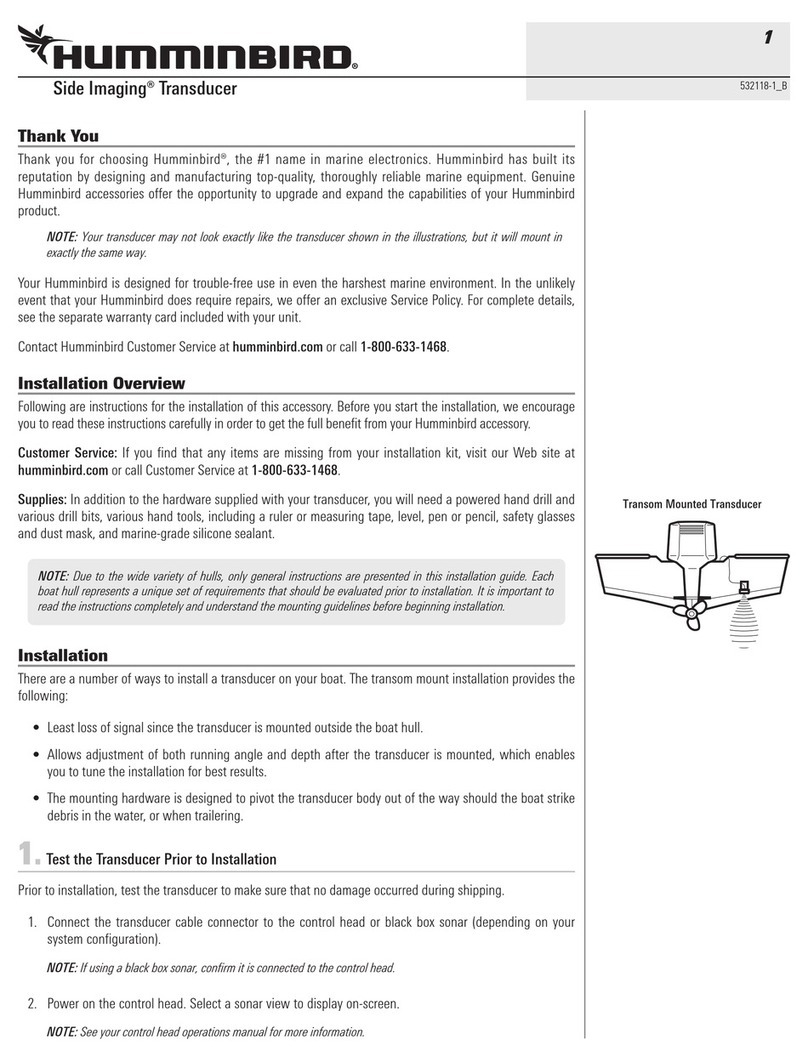
Humminbird
Humminbird Side Imaging Transducer manual

Garmin
Garmin GPSMAP 168 Sounder Owner's manual and reference guide

Moxa Technologies
Moxa Technologies MPC-2000 Series Hardware manual
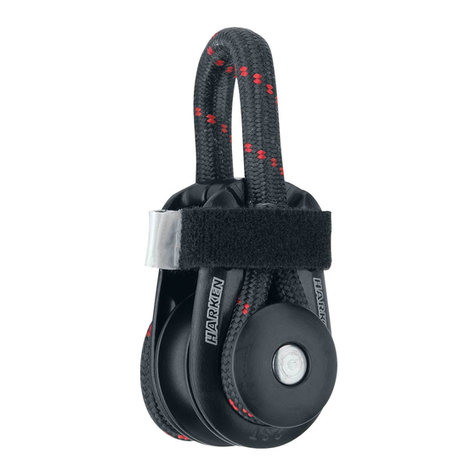
Harken
Harken 3299 instructions
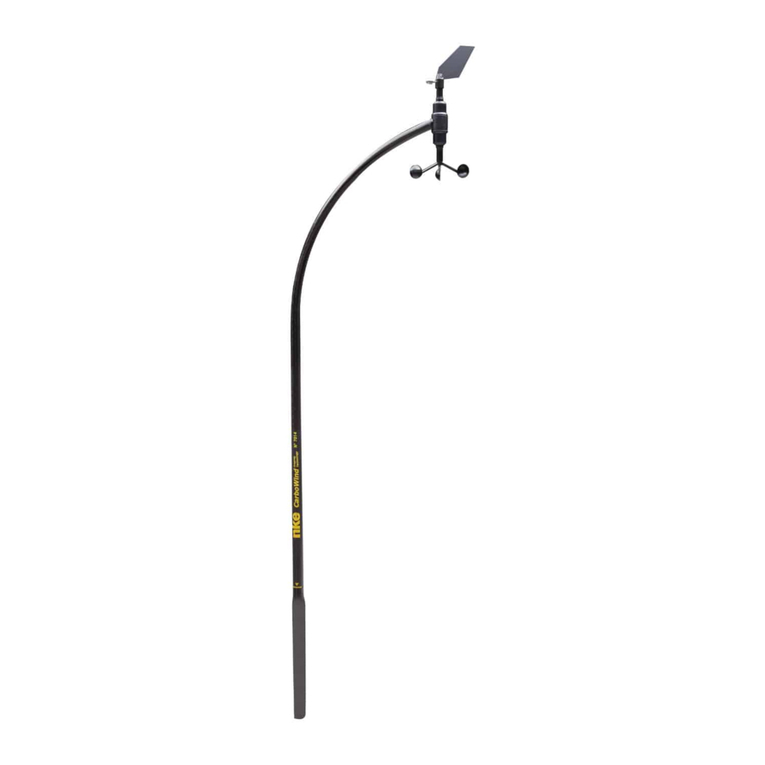
NKE
NKE CARBOWIND HR USER GUIDE and INSTALLATION GUIDE
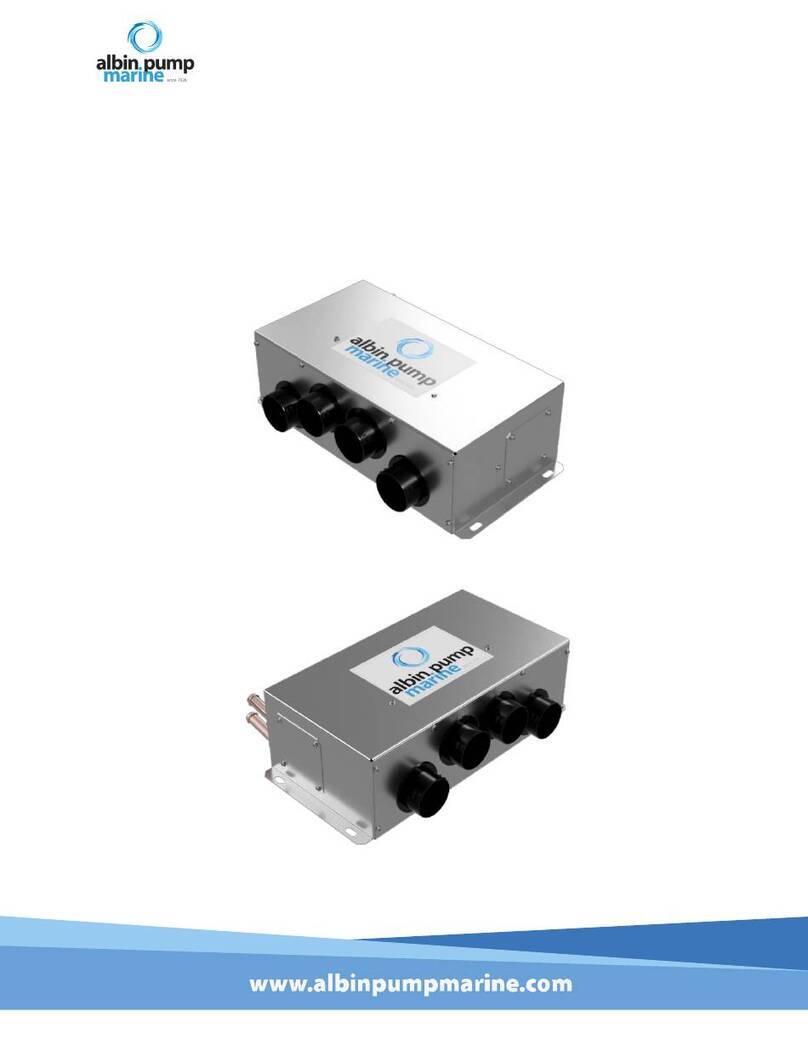
ALBIN PUMP
ALBIN PUMP Marine Defroster 9 kW Instructions for use

